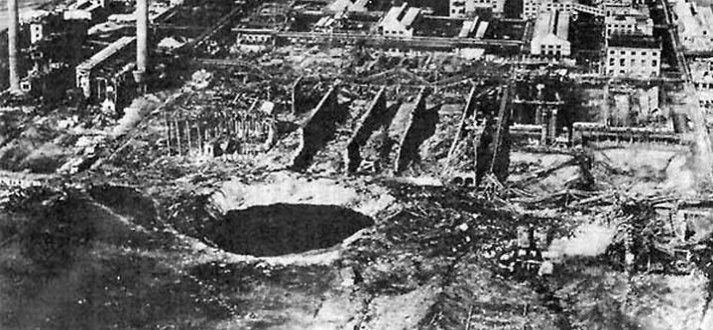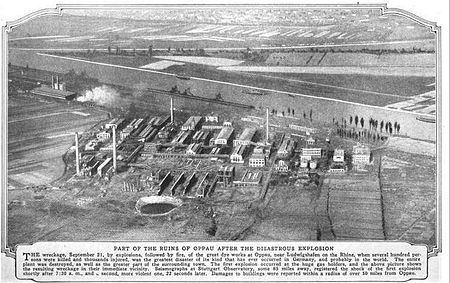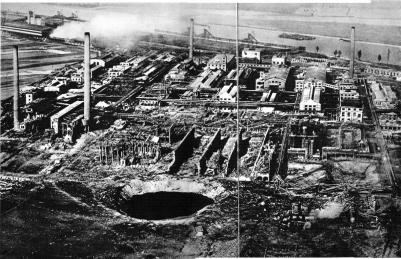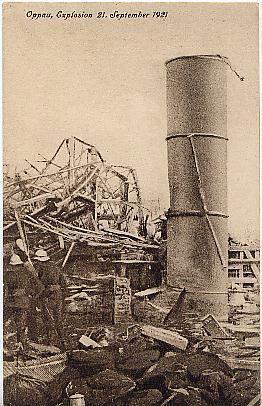Date 21 September 1921 | ||
 | ||
Similar Texas City disaster, West fertilizer Plant expl, Flixborough disaster, AZF Explosion, PEPCON disaster | ||
The Oppau explosion occurred on September 21, 1921, when a tower silo storing 4,500 tonnes of a mixture of ammonium sulfate and ammonium nitrate fertilizer exploded at a BASF plant in Oppau, now part of Ludwigshafen, Germany, killing 500–600 people and injuring about 2,000 more.
Contents

Background

The plant began producing ammonium sulfate in 1911, but during World War I when Germany was unable to obtain the necessary sulfur, it began to produce ammonium nitrate as well. Ammonia could be produced without overseas resources, using the Haber process.

Compared to ammonium sulfate, ammonium nitrate is strongly hygroscopic, so the mixture of ammonium sulfate and nitrate clogged together under the pressure of its own weight, turning it into a plaster-like substance in the 20m high silo. The workers needed to use pickaxes to get it out, a problematic situation because they could not enter the silo and risk being buried in collapsing fertilizer. To ease their work, small charges of dynamite were used to loosen the mixture.

This apparently suicidal procedure was in fact common practice; it was well known that ammonium nitrate was explosive - it had been used extensively as such during World War I - but tests conducted in 1919 had seemed to indicate that mixtures of ammonium sulphate and nitrate containing less than 60% nitrate were unlikely to explode, on which grounds the material handled by the plant, nominally a 50/50 mixture, was considered stable enough to store in 50,000-tonne lots - more than ten times the amount involved in the disaster. Indeed, nothing extraordinary happened during an estimated 20,000 firings, until the fateful explosion on September 21.

As all involved died in the explosion, the causes are not clear. However, it is known from work more recent than the abovementioned 1919 tests that the "less than 60% nitrate = safe" criterion is inaccurate; in mixtures containing 50% nitrate, any explosion of the mixture is confined to a small volume around the initiating charge, but increasing the proportion of nitrate to 55-60% significantly enhances the explosive properties and creates a mixture whose detonation is sufficiently powerful to initiate detonation in a surrounding mixture of a lower nitrate concentration which would normally be considered minimally explosive. Changes in humidity and density also significantly affect the explosive properties.
A few months before the incident, the manufacturing process had been changed in such a way as to lower the humidity level of the mixture from 3-4% to 2%, and also to lower the apparent density. Both these factors rendered it more likely to explode. There is also evidence that the lot of mixture in question was not of uniform composition and may have contained pockets of up to several dozen tonnes of mixture enriched in ammonium nitrate. The explanation is therefore proposed that one of the charges was by chance placed in such a pocket, which exploded with sufficient violence to set off some of the surrounding lower-nitrate mixture.
Two months earlier, at Kriewald, then part of Germany, 19 people had died when 30 tonnes of ammonium nitrate were detonated by people doing the same thing. It is not clear why this warning was not heeded.
Scale of the explosion
The explosion was estimated to be about 1–2 kilotonnes TNT equivalent, and was heard as two loud bangs in north-eastern France and in Munich, more than 300 km away. The pressure wave caused great damage in Mannheim, located just across the Rhine, ripped roofs off up to 25 km away and destroyed windows even further away, namely all the medieval stained-glass windows of Worms cathedral, 15 km to the north. In Heidelberg (30 km from Oppau), traffic was stopped by the mass of broken glass on the streets, a tramway got derailed and even here some roofs were ripped off.
About 80 percent of all buildings in Oppau were destroyed, leaving 6,500 homeless. At ground zero a 90 m by 125 m crater, 19 m deep, was created. Damages were estimated by The New York Times in 1922 at then 321 million Marks (since Germany suffered heavy hyperinflation in 1919–1924, given amounts and exchange-rates are not very descriptive).
According to some descriptions, only 450 tonnes exploded, out of 4,500 tonnes of fertilizer stored in the warehouse.
